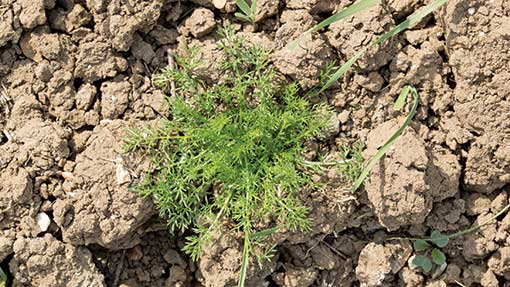Cereals 2014: Don’t ignore broad-leaved weed resistance

With herbicide-resistant grassweeds already widespread, a new case of resistant mayweed shows growers need to be doing all they can to prevent the spread of hard-to-control broad-leaved weeds too. Adam Clarke investigates.
Herbicide resistance in broad-leaved weed populations is underestimated and growers should ensure they are mixing modes of action when applying weedkillers to prevent the problem getting worse.
The warning comes as the first Scottish case of resistance in mayweed to sulfonylurea herbicides was confirmed near Forfar, Angus, after testing at Rothamsted Research.
See also: Read more from Cereals 2014
The three key broad-leaved weeds with confirmed cases of resistance to the ALS-inhibiting sulfonylureas are poppies, chickweed and mayweed.
Richard Hull, weed expert at the Hertfordshire research institute, told Farmers Weekly at Cereals 2014 that he suspects there are many more cases than have been confirmed in both independent and manufacturer testing so far.
But the notoriously difficult task of collecting good seed samples from broad-leaved weed species such as mayweed and chickweed makes the task of monitoring resistance across the country tough.
“Broad-leaved weeds have a much quicker lifecycle and shed seed in a very short period of time, on top of being much smaller than grassweed seed, so it’s tricky,” said Mr Hull.
The Forfar seed sample was sent to Rothamsted in September 2013 and grown in pots in the glasshouse and treated with field rates of two key sulfonylurea herbicides.
Using metsulfuron, in products such as DuPont’s Ally, and florasulam in Dow’s Boxer, results were recorded four weeks after spraying.
About 50% of plants sprayed with metsulfuron survived, but all sprayed with florasulam were killed, indicating the presence of the ALS 197 mutation, which confers resistance to sulfonylurea chemistry such as metsulfuron, but not florasulam-type actives, despite both being ALS inhibitors.
Broad-leaved weed resistance in the UK
- Chickweed: 40 farms in 13 counties of England, Scotland and Wales
- Poppies: 25 farms in nine counties on the east coast of England
- Mayweed: Four farms (one in Scotland, three in Yorkshire)
Target-site resistance occurs when a mutation changes the plant’s genetic make-up, resulting in the herbicide not being able to bind to the target that it is designed to disrupt.
“It often results in very black-and-white results, as the plants either have the mutation or they don’t,” said Mr Hull.
It fires a warning shot to growers, as resistance in the same group of herbicides is already widespread in blackgrass and ryegrass.
Having both herbicide-resistant grassweed and broad-leaved weed populations in the same fields could provide a real headache, resulting in yield losses from heavy weed burdens.
Herbicide-resistant chickweed is largely a Scottish problem, where spring cropping is more widespread and weeds have been controlled using ALS-inhibitors year on year.
However, with blackgrass rife in many parts of England, more growers will be switching to spring cropping – particularly spring barley – to reduce numbers.
“That opens up many other parts of the country to the risk of broad-leaved weed resistance, so growers should make sure they are using best practice when controlling broad-leaved weeds,” warned Mr Hull.
Poppy problem
Resistant poppy populations are also now commonplace, particularly in the eastern counties of England, but Adas weed biologist Lynn Tatnell thinks that growers are managing to keep a lid on the problem at present.
Pre-emergence oilseed rape herbicide metazachlor and aminopyralid and propyzamide-containing AstroKerb applied post-emergence is providing good control in most rotations, she added.
“The key message is not to rely on ALS-inhibiting chemistry through the rotation, with pendimethalin, MCPA, bromoxynil and ioxynil, among others, also providing a variety of alternative modes of action,” said Mrs Tatnell.
Enhanced metabolism herbicide resistance has not been confirmed in broad-leaved weeds, but Mr Hull had a feeling it was present in some species, allowing plants to detoxify themselves of the herbicide and grow away.
Work at Rothamsted has shown differences between active ingredients when controlling broad-leaved weeds, with some being more effective than others on some species.
“It is important for growers to be able to identify their weeds at an early stage and use a range of actives that are most active against the species present.
“Cultural controls are much more difficult to deploy against broad-leaved weeds, therefore we need to ensure we are maximising the effect of herbicides and protecting them against resistance,” said Mr Hull.

